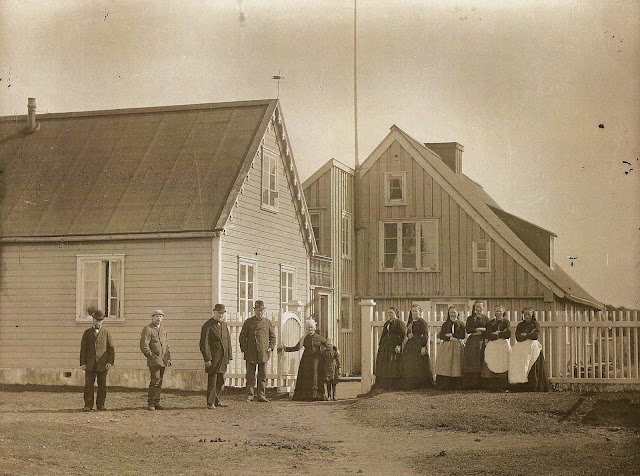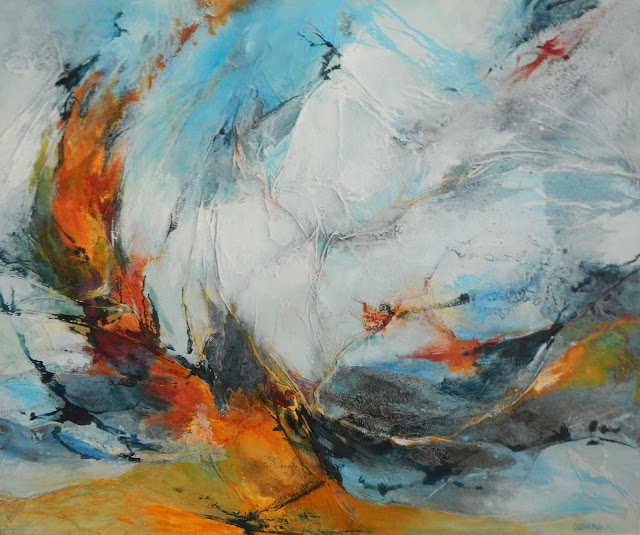Washington Island, Wisconsin -
Here's more about our trip to Iceland.
So many have commented on how they enjoyed the photos and commentary I posted on our trip to Iceland that I've decided to extend this topic.
Many points of interest are within an easy several hours' drive from Reykjavik. Many tour companies will pick you up and return you to your hotel after an outing in the countryside. But I would encourage any traveler to Iceland, if you have time, to also overnight outside of the capital city. The major roads are good roads and are paved, sometimes with small or no shoulders. Graveled roads that we encountered were a bit rough, but not unexpectedly so. You drive on the right hand side, which makes it easy. Icelanders speak English and Danish as second and third languages. You'll have no problem communicating.
Our general impression of Iceland was one of extremely friendly and helpful people.
There must be exceptions, but we didn't encounter them during our stay, although we passed close by Iceland's national prison at Litla Hraun, less than a mile from Eyrarbakki and, coincidentally, the address used in letters mailed to Arni Gudmundsen by his sister in the 1880s when it was farmland.
This prison might well be the major local employer. This is where Iceland's most hardened criminals are housed, and razor wire and fencing aside, the prison farmyard gives off the look of a work farm. We learned later from our driver on our way to the airport that there are about 80 cells in this prison, with another 40 being planned for the future closer to Reykjavik.
Reading online information, Iceland has 137 prisoners in all, on average, per day, some held in smaller prisons elsewhere than Eyrarbakki. The average is 43 per 100,000 population, as compared with USA's 756 per 100,000. Why the rather low number of incarcerated prisoners, we wonder? One reason may be, if you are given a prison term, you could wait from several days or weeks up to five years to serve your term, whenever a cell opens up. Descriptions I've read for the prison facilities posted on line describe it as "not quite four-star," but not rough, either. Prisoners are encouraged to make the best of their time by either working or enrolling in education classes.
Our driver translated a couple of expressions into English for us. Here is one: If I say I want to "kick his ass," I say, "I'm going to take him to the bakery." Putting it into English, that's about as sweet a deliverance could be.
Years ago, according to the sagas, vicious crimes were settled through agreed payment of silver, cattle or horses to the offended surviving family, and ultimately, banishment by the Althing court, sending the violent offender from Iceland for three years. Could there still be an unwritten form of societal banishment practiced, in lieu of incarceration?
Horse riding - a popular pastime
Horse riding is one of the easiest ways to get around such a rough and tumble countryside, and stables can be found in many locations. Evy took the opportunity to trail ride on our trip to Westman Islands. As it happened, she was the only rider that afternoon. She was picked up and dropped off at the ferry by the woman whose family has the stable, maximizing her time on the trail. And because of her experience, she was given a chance to ride one of the owner's personal mounts. Along the trail there was plenty of time to compare the similarities of life on Washington Island with Heimaey, the largest of the islands in the chain. (With approx. 5,000 population) As it happened, along one trail Evy came within 20 feet of a Puffin. It was the only Puffin the owner has seen this season thus far. More birds will arrive later in summer for nesting.
Birding is a popular activity, both for locals and for visitors. Besides sighting birds, there is a tradition on Heimaey and neighboring (and otherwise uninhabited) islands to collect Puffin eggs, and also Puffins. This tradition goes back many years, and it appears to be closely regulated. Young men practice swinging on ropes, a technique they use to gather eggs. Puffin is served on some restaurant menus, although we didn't try it. During their tour of the island, our grandsons had the chance to try the rope swing, tutored by their guide.
On our way to and from the port we did see many sea birds that I thought were terns or gulls nesting in the thousands of pockets within the cliffs. The lone houses built on top of the cliffs are there as dwellings for the sheepherders and egg collectors, and establishment of a dwelling also goes with ownership, the right to collect birds and eggs.
 |
| This Icelandic Black-tailed Godwit was looking for food in the tall grasses near the top of the crater, along a trail frequented by hikers. Cropping the original photo has reduced the definition. |
A day or so earlier, while overlooking a crater, I spotted an unfamiliar bird with my binoculars. Later, I learned it was an Icelandic Black-tailed Godwit, fairly rare, at least to non-Icelanders. This is a long-legged, long-beaked coastal wader that nests in grasses, usually in the lowlands. Judging by its bright, rust-colored head, this one was a male.
According to a birding site at www.arkive.org, this bird has a most unusual migration characteristic that allows it to mate:
"Black-tailed godwits meet in Iceland from mid-May to mid-June to breed, and in an amazing act of fidelity and timing, faithful pairs meet after over-wintering up to 600 miles apart. Arriving within three days of each other, pairs mate, breed and incubate their eggs together. The male remains with the hatchlings for a short time after the female has left to migrate back to her winter home. At the point the male leaves, he is unaware of the location of his partner, and so migrates elsewhere. This monogamous lifestyle can continue for up to 25 years and is only broken if the male and female fail to arrive within the same three days. There is, as yet, no understanding of how the pairs time their migrations with such accuracy."
Hot dogs, anyone?
Said to be a modern day Icelandic national food, our family members found the excellent Icelandic hot dogs available at small stands in various locations. One such place was a franchise stand in the center of Selfoss, discovered accidentally one day while on the way to the grocery store, and altogether six return trips were made by Hoyt, Thor and Chad. These hot dogs (we think they may be lamb hot dogs) are typically served with mayonnaise, onions, sweet mustard, and maybe ketchup, on a toasted bun.
 |
| Thor had to have one last hot dog at the Keflavik airport before flying home. |
Woolen goods
Few who live in warmer climates can resist the beautiful woolen wear one finds for sale in many Icelandic shops. The wool is known for its high lanolin content, it is soft, and the colors are generally natural, undyed colors. Look carefully, though, as some sweater garments we found were knitted in China, or elsewhere, using Icelandic wool. Nice, but nothing like having a sweater knit by Icelandic fingers.
Co-ops, in addition to many retailers, sell woolen goods produced by local knitters. Prices may seem steep, but not for a warm sweater that will wear like iron, shed water and sleet, and help keep the wearer dry by wicking away body moisture. There are no fleece products quite their equal. There are fine wool dresses, jackets, and other stylish wear for ladies, in addition to the unisex sweaters. You will see these sweaters worn everywhere, especially outdoors and when horse riding. (Rain clouds are never far away.) I got mine, a 3X found in a rack at the Gullfoss (waterfall) souvenir shop. Here are Evy and son Atlas sporting hooded sweaters.
 |
| Thor, Mary Jo and Evy alongside the Gullfoss gorge. |
 |
| Evy with son, Atlas. |
So, we'll wrap up this extended Iceland visit with a few more photos, encouraging anyone who is able to visit Iceland.
 |
| Looking toward Westman Islands from black sand beach near the ferry jetty. |
A poem by Eggert Olafsson (1726-1768) -
We have traveled far across the land
deserts, lava, sand,
glaciers, rivers, mountains steep,
caves, cliffs and chasms deep
- a comfortable journey from start to end.
- Dick Purinton
 |
| View toward Eyjafjallajokull glacier. |









































